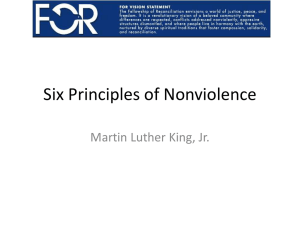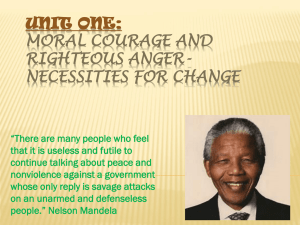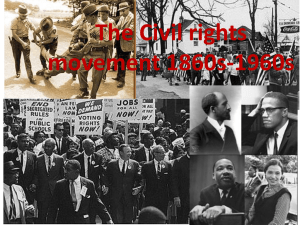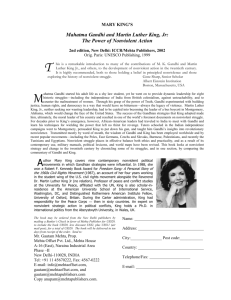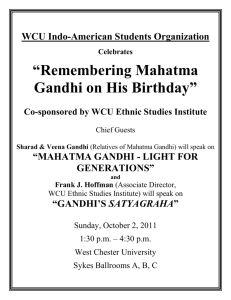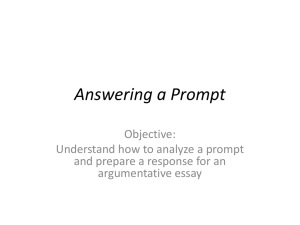Nonviolence and Peace Education
advertisement
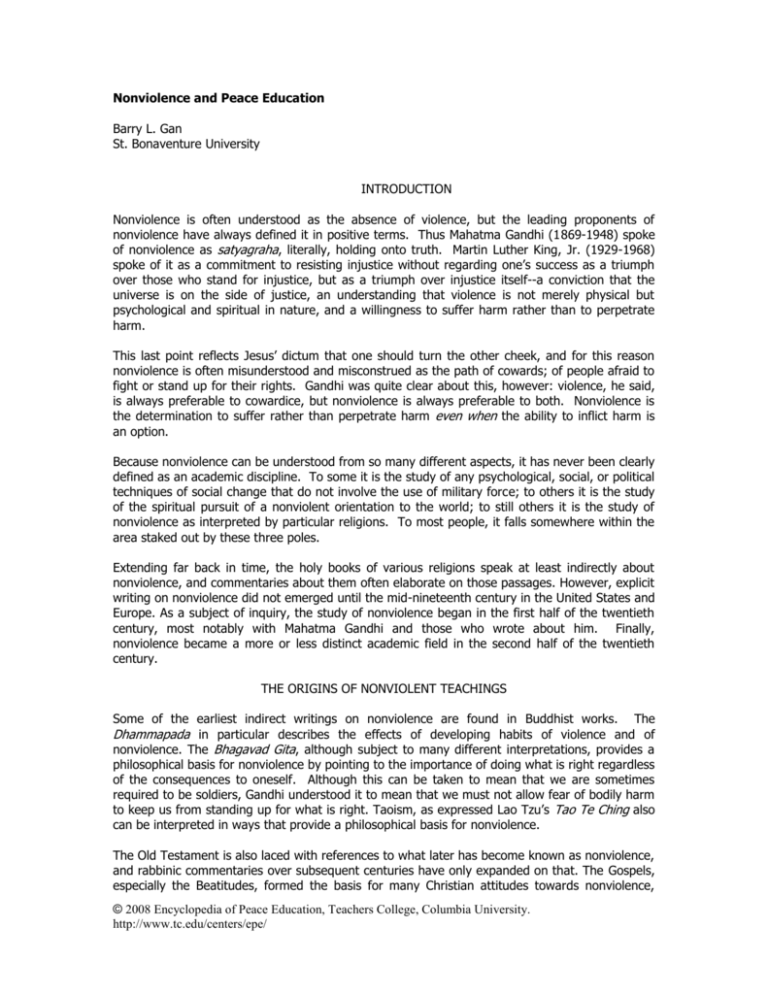
Nonviolence and Peace Education Barry L. Gan St. Bonaventure University INTRODUCTION Nonviolence is often understood as the absence of violence, but the leading proponents of nonviolence have always defined it in positive terms. Thus Mahatma Gandhi (1869-1948) spoke of nonviolence as satyagraha, literally, holding onto truth. Martin Luther King, Jr. (1929-1968) spoke of it as a commitment to resisting injustice without regarding one’s success as a triumph over those who stand for injustice, but as a triumph over injustice itself--a conviction that the universe is on the side of justice, an understanding that violence is not merely physical but psychological and spiritual in nature, and a willingness to suffer harm rather than to perpetrate harm. This last point reflects Jesus’ dictum that one should turn the other cheek, and for this reason nonviolence is often misunderstood and misconstrued as the path of cowards; of people afraid to fight or stand up for their rights. Gandhi was quite clear about this, however: violence, he said, is always preferable to cowardice, but nonviolence is always preferable to both. Nonviolence is the determination to suffer rather than perpetrate harm even when the ability to inflict harm is an option. Because nonviolence can be understood from so many different aspects, it has never been clearly defined as an academic discipline. To some it is the study of any psychological, social, or political techniques of social change that do not involve the use of military force; to others it is the study of the spiritual pursuit of a nonviolent orientation to the world; to still others it is the study of nonviolence as interpreted by particular religions. To most people, it falls somewhere within the area staked out by these three poles. Extending far back in time, the holy books of various religions speak at least indirectly about nonviolence, and commentaries about them often elaborate on those passages. However, explicit writing on nonviolence did not emerged until the mid-nineteenth century in the United States and Europe. As a subject of inquiry, the study of nonviolence began in the first half of the twentieth century, most notably with Mahatma Gandhi and those who wrote about him. Finally, nonviolence became a more or less distinct academic field in the second half of the twentieth century. THE ORIGINS OF NONVIOLENT TEACHINGS Some of the earliest indirect writings on nonviolence are found in Buddhist works. The Dhammapada in particular describes the effects of developing habits of violence and of nonviolence. The Bhagavad Gita, although subject to many different interpretations, provides a philosophical basis for nonviolence by pointing to the importance of doing what is right regardless of the consequences to oneself. Although this can be taken to mean that we are sometimes required to be soldiers, Gandhi understood it to mean that we must not allow fear of bodily harm to keep us from standing up for what is right. Taoism, as expressed Lao Tzu’s Tao Te Ching also can be interpreted in ways that provide a philosophical basis for nonviolence. The Old Testament is also laced with references to what later has become known as nonviolence, and rabbinic commentaries over subsequent centuries have only expanded on that. The Gospels, especially the Beatitudes, formed the basis for many Christian attitudes towards nonviolence, © 2008 Encyclopedia of Peace Education, Teachers College, Columbia University. http://www.tc.edu/centers/epe/ especially among the Society of Friends and such Anabaptists as the Mennonites and the Brethren. Adin Ballou (1803-1890), a nineteenth-century American minister and writer, gave explicit expression to the Christian call to nonviolence, as did Leo Tolstoy, the Russian novelist and Christian anarchist. MAHATMA GANDHI AND THE SCIENTIFIC STUDY OF NONVIOLENCE The scientific study of nonviolence probably began with Mahatma Gandhi. However, rather than treating nonviolence as an academic pursuit he tested his theories in the world, which he regarded as a laboratory. His study of nonviolence ( ahimsa) consisted of testing whether his hypotheses were borne out through experience. His term satyagraha, which has been translated as “soul force,” literally means “holding onto (graha) truth (satya).” The root word of satya, sat, means “being,” and Gandhi regarded violence as the destruction of being, of what is; of untruth as the destruction of what is real. Perhaps one way to understand what Gandhi meant by satyagraha is to picture an episode early in his life, when a stagecoach driver attempted to remove him from the carriage for which he had a legitimate ticket. A few days earlier he had been thrown from a train for insisting upon using his ticket to ride in the first-class coach rather than on top. This time, he was so angered by the injustice of it that he grasped the window frame of the carriage with both his arms as the driver tried to pull him away by his legs. The other passengers eventually intervened and insisted that Gandhi be allowed to ride inside the coach. This image of Gandhi grasping onto the coach window and not letting go, but at the same time not striking out, is one way of understanding what he meant by satyagraha, literally “clinging to truth.” Several people studied and wrote about Gandhi’s work while he was alive, most notably Richard Gregg and Joan Bondurant. Both visited Gandhi and interviewed him, Gregg in the 1920s and Bondurant in the 1940s. Both of their writings tended to focus on the dynamics of his nonviolent political action, including what he called his constructive programs: his efforts to help people overcome their own powerlessness through self-education, self-employment, and selfsufficiency. After Gandhi’s assassination in 1948, more writing emerged. Gene Sharp recognized the politically strategic brilliance of Gandhi’s methods, and in 1973 he published a work that has become a classic in the field, The Politics of Nonviolent Action. The work did not focus specifically on Gandhi, but offered in the first two chapters a theoretical framework for understanding the power of nonviolence; in the next seven chapters an overview of approximately two hundred nonviolent tactics, from simple letter-writing to the establishment of alternative governments; and in the remaining chapters an analysis and blueprint of how to create and execute nonviolent campaigns strategically as well as tactically. A little less than a decade later, in 1982 Richard Attenborough’s Academy Award-winning film Gandhi popularized Gandhi to a much greater extent. In no small way because of the film, Gandhi-based scholarship and discourse on nonviolence has become so widespread and deep that theoretical splits within the field are already evident. NONVIOLENCE IN THE TWENTIETH CENTURY At the outset of the twenty-first century, the academic field of nonviolence is divided--not sharply, but divided nonetheless. While many activists and academics have approached nonviolence from a spiritual or religious perspective, perhaps most notably those associated with the Fellowship of Reconciliation, others have followed the lead of Gene Sharp, focusing on nonviolence as a political strategy that, arguably, can be entirely secular in its orientation. Still others adopt a broader approach. 2 For over half a century, James Lawson has been a leading voice of those who approach nonviolence from a religious or spiritual base. Lawson organized the Nashville lunch counter sitins in the early 1960s that led to the desegregation of Nashville. Earlier he had served time in jail for refusing to register for military service. In the late 1960s, it was Lawson who invited Martin Luther King, Jr., to come to Memphis to help with the sanitation worker strikes. After leading a large church in Los Angeles for many years in the latter half of the twentieth century, and serving some of that time as Chair of the Executive Committee of the U.S. Fellowship of Reconciliation, he is presently a distinguished visiting professor at Vanderbilt University, which had expelled him so many years earlier for his efforts at integration. Gene Sharp’s work has attracted a large following, and recently his ideas have enjoyed widespread attention. The production of the PBS series A Force More Powerful and a follow-up broadcast Bringing Down a Dictator attracted people worldwide to the practical applications of nonviolent strategy and tactics in the political and social arenas. The International Center on Nonviolent Conflict, an NGO established by Peter Ackerman and headed by Jack DuVall, has helped to disseminate these ideas and develop them further by supporting scholarship, workshops, and conferences around the world. The workshops and conferences have brought together academics and activists from across Asia, Eastern and Western Europe, Latin America, and North America. The result has been a sharing of course materials and scholarship as well as exchanges of ideas among and between those who practice nonviolent action and those who study it. An eclectic approach to nonviolence has been championed most notably in the last third of the twentieth century and the early years of the twenty-first century by Michael Nagler of the University of California at Berkeley, Ken Brown of Manchester College, and Robert L. Holmes of the University of Rochester. Holmes, Brown, and Nagler draw heavily from the Gandhi’s work, emphasizing the spiritual roots of nonviolence and acknowledging its manifold applications in everything from personal development and personal relations to institutional practices and international relations. Their scholarship teaching and personal conduct have led to accolades from students across several generations. REFERENCES Ackerman, Peter and DuVall, Jack. 2000. A Force More Powerful . New York. St. Martin’s Press. Ansbro, John J. 1984. Martin Luther King, Jr.: The Making of a Mind. Maryknoll, NY: Orbis Books. Bondurant, Joan V. 1988. Conquest of Violence: Princeton, NJ: Princeton University Press. The Gandhian Philosophy of Conflict. Gandhi, M. K. 1993. Autobiography: The Story of my Experiments with Truth. Boston: Beacon Press. —— 2002. The Essential Gandhi: An Anthology. Edited by Louis Fischer. New York: Vintage. —— 1999. Vows and Observances. Berkeley, CA: Berkeley Hills Books. Gregg, Richard B. 1966. The Power of Nonviolence. New York: Schocken Books. Lynd, Staughton, (editor). 1966. Nonviolence in America: A Documentary History. Indianapolis: Bobbs-Merrill. Holmes, Robert L., and Gan, Barry L., (editors). 2006. Nonviolence in Theory and Practice. Long Grove, Illinois: Waveland. 3 Nagler, Michael. 2001. Is There No Other Way: The Search for a Nonviolent Future. Berkeley, CA: Berkeley Hills Books. Sharp, Gene. 1973. The Politics of Nonviolent Action. Boston: Porter Sargent. Tolstoy, Leo. 1961. The Kingdom of God Is Within You. New York: Noonday Press. Zunes, Stephen, Kurtz, Lester, and Asher, Sarah Beth, (editors). Movements: A Geographical Perspective. Oxford: Blackwell. 1999. Nonviolent Social 4
